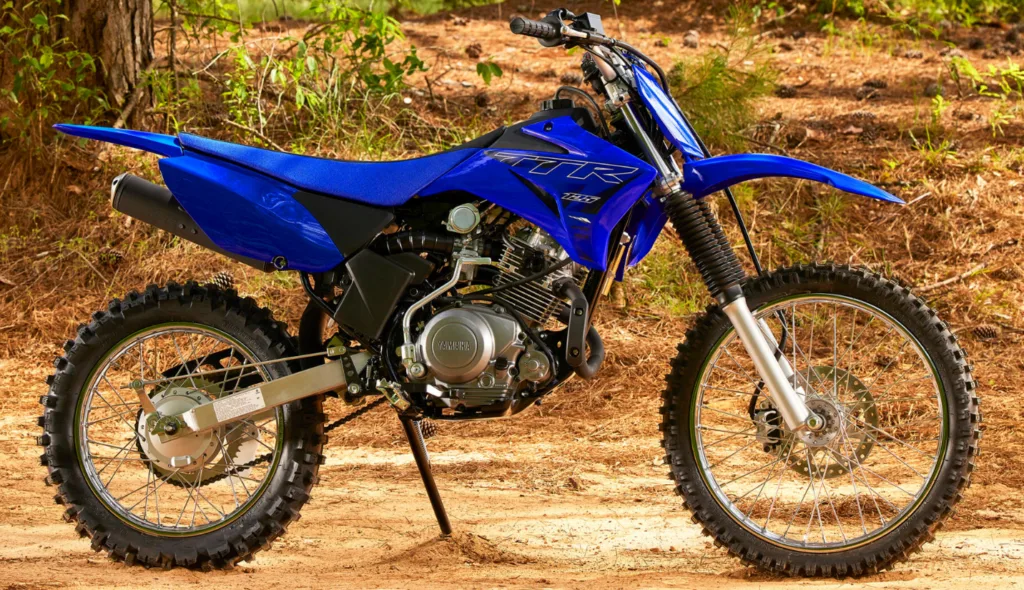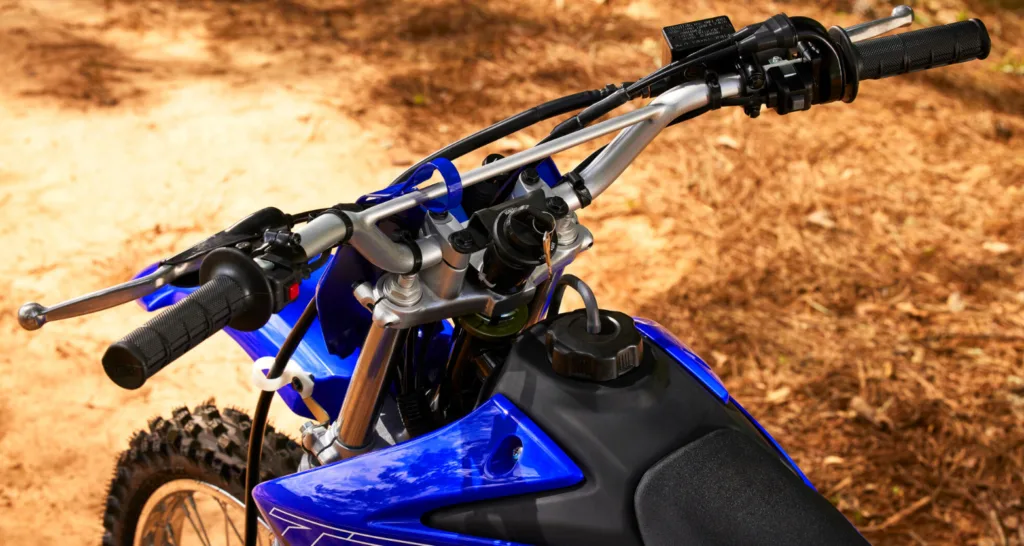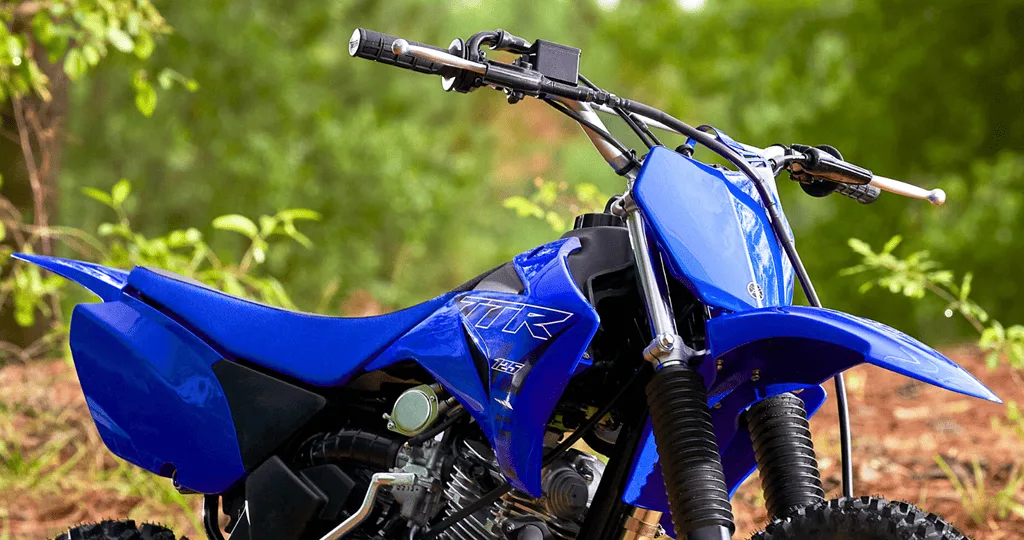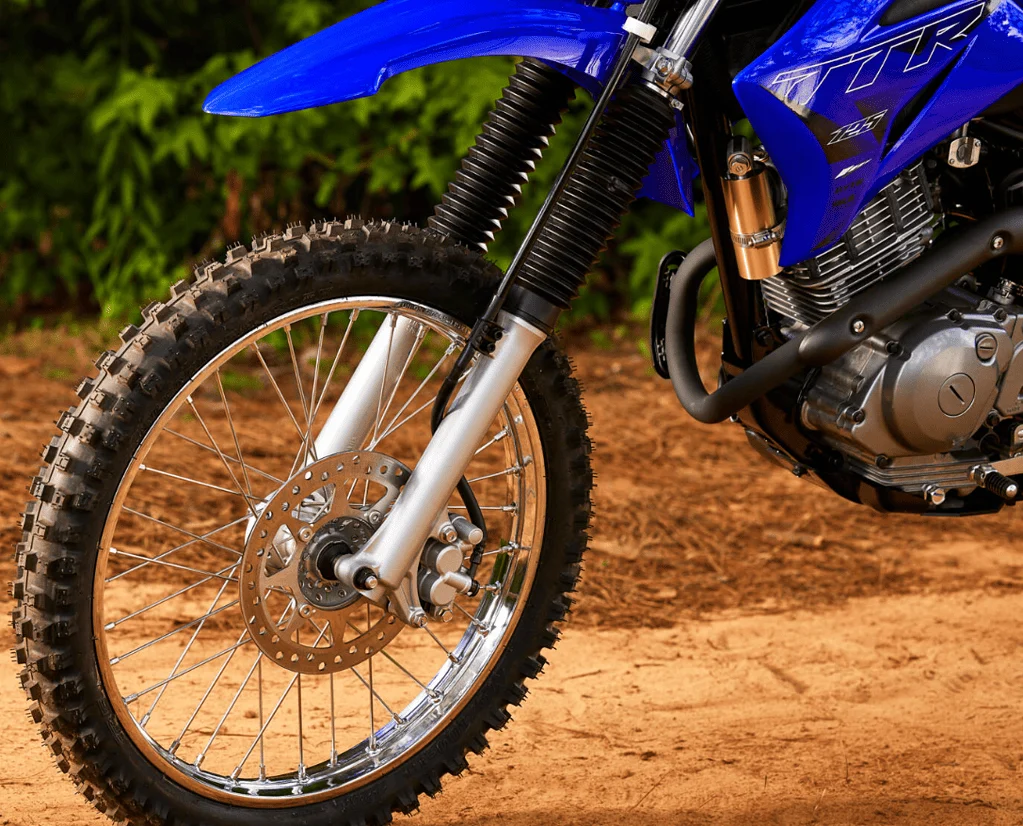The Yamaha TTR 125 is a legendary dirt bike renowned for its impressive specifications and exceptional features. Designed with beginners and teenagers in mind, the Yamaha TTR 125 has carved a prominent place in the off-road world.
The Yamaha TTR 125, a popular off-road dirt bike, offers a top speed of 50-55 mph. It features an electric start, knobby tires, adjustable suspension, and a durable 124cc, air-cooled engine. Perfect for beginners and intermediates, it delivers exceptional performance on diverse terrains.
In this article, I delve into the depths of this thrilling machine, uncovering its power, performance, and standout attributes that set it apart from its competitors. So get ready to explore the exhilarating world of the Yamaha TTR 125, where speed, specs, and remarkable features converge to deliver an unforgettable riding experience.
Specifications of Yamaha TTR 125:
The Yamaha TTR 125 is a dirt bike designed for off-road use. It comes in two versions, the TTR 125 and TTR 125L, with some specs differences. Here let me present you the main specs of the TTR 125:
Category | Specification |
Engine | 124cc air-cooled, 4-stroke, SOHC engine |
Bore x Stroke | 54.0mm x 54.0mm |
Compression Ratio | 10.0:1 |
Fuel System | Mikuni VM20 carburetor |
Ignition | CDI |
Transmission | 5-speed with manual clutch |
Final Drive | Chain |
Chassis | Semi-double cradle steel frame |
Front Suspension | Telescopic fork, 31mm diameter, 4.5 inches travel |
Rear Suspension | Swingarm with Monocross suspension, 5.2 inches travel |
Front Brake | 220mm single disc |
Rear Brake | 110mm drum |
Front Tire | 70/100-19 |
Rear Tire | 90/100-16 |
Wheelbase | 49.4 inches |
Ground Clearance | 10.4 inches |
Seat Height | 31.7 inches |
Fuel Capacity | 1.6 gallons |
Weight | 198 lbs (wet) |
The TTR 125L is similar to the TTR 125 but with a few upgrades, such as a giant front wheel (19-inch) and a rear wheel (16-inch), which makes it taller than the regular TTR 125, as well as a front disc brake and a rear disc brake for improved stopping power.
Overall, the Yamaha TTR 125 is famous for beginners and intermediate riders who want a reliable, easy-to-handle dirt bike for off-road adventures.
Yamaha TTR 125 Top Speed:
While the Yamaha TTR 125 is not known for its high top speed, it’s essential to understand that speed is not the primary focus of this dirt bike.
The TTR 125 is designed to balance power, control, and reliability, making it suitable for beginners and young riders learning to ride off-road.
The reported top speed range for the TTR 125 is around 45-55 MPH (72-88 KM per hour), which is ample for most off-road situations.
Instead of chasing top speed records, the TTR 125 prioritizes manageable power delivery and maneuverability, allowing riders to focus on building their skills and enjoying the adventure of off-road riding.
How to Increase the TTR 125’s Top Speed?
If you’re interested in increasing the top speed of your Yamaha TTR 125, there are several tips and tricks you can consider.
Let me explain the methods below:
1. Weight Reduction:
One way to increase the top speed is by reducing the bike’s weight. You can achieve this by removing unnecessary accessories or components, such as luggage racks or guards, that add extra weight.
2. Carburetor Tuning:
Proper carburetor tuning can optimize the air-fuel mixture, improving engine performance. Consult a professional or refer to the manufacturer’s guidelines for guidance on adjusting the carburetor settings for better speed.

3. Fueling:
Using high-quality fuel with the recommended octane rating can positively impact the bike’s performance. It ensures efficient combustion and may lead to a slight increase in top speed.
4. Tire Replacement:
Upgrading to high-performance tires designed for off-road riding can enhance traction and grip, allowing the bike to accelerate more effectively. However, remember that tire selection should also consider the terrain and riding conditions.
5. Sprocket Modification:
Changing the sprocket sizes can alter the gear ratios and increase the bike's top speed. Installing a larger rear sprocket or a smaller front sprocket can provide a higher top speed, but this may come at the cost of sacrificing low-end torque.
6. Install a High-Performance Exhaust System:
Upgrading the exhaust system can increase the engine’s power output, which can lead to higher top speeds. A free-flowing exhaust system can also improve the engine’s efficiency and reduce back pressure.
7. Upgrade the Air Intake System:
Upgrading the air intake system can help increase the airflow into the engine, allowing it to burn more fuel and produce more power. To achieve this, a high-performance air filter or a cold air intake system can be installed.
8. Upgrade the Suspension:
Upgrading the suspension can help improve stability at higher speeds, allowing the bike to handle better and feel more planted on the road.
It’s important to note that any modifications made to a TTR 125 should be done cautiously and with proper knowledge of how they may affect the bike’s performance and safety. Additionally, adhering to any regulations or laws regarding modifications to motorcycles in your area is essential.
Also check out: Is Riding a Dirt Bike Hard? What You Need to Know
Overview of Yamaha TTR 125:
The Yamaha TTR 125 is a dirt bike that has gained significant popularity and built a strong reputation among riders, particularly beginners and teenagers. It is recognized as a reliable and capable off-road motorcycle that strikes a balance between performance, durability, and user-friendly features.

- One of the standout features of the TTR 125 is its excellent build quality and design. Yamaha has taken inspiration from its YZ motocross bike series, incorporating similar bodywork and styling cues into the TTR 125. This gives the bike an aggressive and sporty appearance, appealing to riders who want a dirt bike that looks the part.
- Compared to its competitors, the TTR 125 offers several improvements that set it apart. Yamaha has emphasized making the bike accessible and easy to handle, making it a suitable choice for riders of various skill levels.
- The ergonomic design ensures a comfortable riding experience, with a manageable seat height and a well-balanced weight distribution. This makes riders feel confident and in control, especially when navigating challenging off-road terrains.
- Furthermore, the TTR 125 benefits from Yamaha’s reputation for producing reliable and durable motorcycles. Using high-quality materials for components like side panels, fenders, and tank panels ensures that the bike can withstand the rigors of off-road riding.
- It can handle rough conditions, such as bumps, jumps, and vibrations, without compromising its performance or structural integrity.
The Yamaha TTR 125 has garnered popularity among riders due to its reliable performance, user-friendly design, and durable construction.
Its features and improvements make it a standout choice in its class, attracting beginners and young riders seeking a capable off-road motorcycle.
Whether tackling trails, exploring dirt tracks, or simply having fun in the great outdoors, the TTR 125 is well-regarded for its combination of performance, versatility, and Yamaha's commitment to quality.
I have also summarised the overview in the table below:
Feature/Aspect | Description |
Popularity and Reputation | Highly popular among beginners and teenagers |
Standout Features | Aggressive bodywork inspired by Yamaha's YZ motocross bikes User-friendly design and ergonomics Excellent build quality and durability |
Accessibility and Handling | Suitable for riders of various skill levels |
Ergonomics | Comfortable seat height and balanced weight distribution Easy maneuverability and control |
Design and Styling | Inspired by Yamaha's YZ motocross bike series |
Build Quality and Durability | High-quality materials for enhanced durability Capable of withstanding rough off-road conditions |
1. TTR 125 Has a 124cc 4-Stroke Engine:
The Yamaha TTR 125 is equipped with a 124cc four-stroke engine. The “124cc” refers to the engine’s displacement, which represents the total volume of all the cylinders in the engine. A larger displacement generally indicates more power and torque.
1.1. Engine Power Output:
The TTR 125’s engine produces a moderate power output suitable for beginners and young riders.
While the exact power output may vary depending on the model year and any modifications, it typically ranges from 8 to 11 horsepower.
The power output is the amount of work the engine can do per unit of time and is responsible for propelling the bike forward.
1.2. RPM (Revolutions Per Minute):
The engine’s RPM refers to the number of complete revolutions it makes in one minute.
The TTR 125's engine has a maximum RPM range of around 7,000 to 8,000. A higher RPM indicates that the engine is spinning faster and can deliver more power when needed.
1.3. Torque:
Torque is the twisting force produced by the engine. The TTR 125's engine generates a respectable amount of torque, typically 7 to 8 lb-ft (pound-feet)@6500RPM.
Torque plays a crucial role in off-road riding as it helps overcome obstacles, climbs steep inclines, and provides the necessary low-end power for quick acceleration from a standstill.
Let me also provide you a tabular view below for a concise overview of the power output, RPM range, and torque of the Yamaha TTR 125.
Yamaha TTR 125 Specification | Value |
Power Output | 8 - 11 horsepower |
RPM Range | 7,000 - 8,000 RPM |
Torque | 7 - 8 lb-ft (pound-feet) @6500RPM |
2. TTR 125 Comes with Safe Brake:
2.1. Reliable Drum Brakes:
The Yamaha TTR 125 has reliable drum brakes on both the front and rear wheels. Drum brakes are commonly used in off-road bikes due to their robustness and ability to withstand dirt, mud, and water encountered during off-road riding.
2.2. Importance of Reliable Brakes:
Having reliable brakes is crucial when riding off-road. It allows you to maintain control and ensure safety, especially when navigating challenging terrains, steep slopes, or unexpected obstacles.
The TTR 125’s drum brakes provide consistent stopping power, allowing riders to handle various off-road conditions confidently.
2.3. Maintenance Tips:
To keep the braking system in good condition, regular maintenance is essential. Here are a few tips you can follow:
- Cleaning: After each ride, clean the brake drums and components using a soft brush and mild detergent to remove any dirt or debris that may have accumulated.
- Inspection: Inspect the brake pads, shoes, and drums for wear. Replace them if they are worn beyond the recommended limits.
- Lubrication: Apply a thin layer of high-temperature brake grease to the brake components’ pivot points and contact surfaces to ensure smooth operation.
- Adjustment: Check and adjust the brake lever or pedal free play according to the manufacturer’s guidelines. Improper adjustment can affect braking performance.
2.4. Expert Tip:
It’s good practice to check the braking system before each ride. Ensure that the brake levers and pedals feel firm and responsive and that there are no unusual noises or vibrations when applying the brakes. If you notice any issues, have a professional mechanic inspect and service the brakes.
3. TTR 125 Has Incredible Ergonomics and Handling:
The Yamaha TTR 125 is known for its exceptional ergonomics and handling, greatly enhancing the rider’s comfort and control on various terrains. Here are the key aspects to consider:
3.1. Ergonomic Design and Low Center of Gravity:
The TTR 125 features an ergonomic design that ensures a comfortable riding position for both beginner and experienced riders. In addition, the bike's low center of gravity improves stability, balance, and maneuverability.
This design element allows riders to maintain better control over the bike, especially when navigating challenging off-road conditions.
3.2. Handlebar Design and Chassis:
The handlebar design of the TTR 125 is precisely engineered to offer precise control and responsiveness. The handlebars are positioned at an optimal height and angle, providing riders with a natural grip and comfortable reach.
This feature allows riders to maneuver the bike, easily enhancing their overall riding experience. In addition, the chassis of the TTR 125 is designed to be lightweight yet sturdy, further enhancing the bike’s handling characteristics.

3.3. Comfortable Seat Height:
The TTR 125 has a seat that offers a comfortable position for riders of various heights. The seat height is carefully designed to balance accessibility and control.
This ensures that riders can comfortably reach the ground with their feet while maintaining proper control over the bike. The comfortable seat height reduces rider fatigue and allows for extended riding enjoyment.
3.4. Manageable Weight:
The TTR 125 has a manageable weight, making it easier to handle and maneuver, especially for beginner riders.
The lightweight construction of the bike contributes to its agility, allowing riders to navigate tight trails, corners, and obstacles confidently.
The manageable weight also aids in controlling the bike during jumps and other off-road maneuvers.
4. TTR 125’s Bodywork Inspired by Yamaha’s YZ Motocross Bike Series:
The bodywork of the Yamaha TTR 125 takes inspiration from Yamaha’s renowned YZ motocross bike series. This design influence enhances the bike’s aesthetics and contributes to its overall performance.
The aggressive styling cues and sleek lines give the TTR 125 a sporty and dynamic appearance reminiscent of high-performance motocross bikes.
4.1. Use of Durable Materials for Side Panels, Fenders, and Tank Panels:
Yamaha has engineered the TTR 125 with durability in mind. As a result, the bike features high-quality materials for its side panels, fenders, and tank panels.
These components are built to withstand the demands of off-road riding, where encounters with branches, rocks, and other obstacles are common.
In addition, the robust construction ensures the TTR 125 can handle the rough and challenging conditions often encountered on dirt tracks and trails.

4.2. Ability to Handle Rough Riding Conditions:
The Yamaha TTR 125 is designed to excel in harsh riding conditions. Its sturdy frame and suspension system are engineered to absorb shocks and provide a comfortable ride even on bumpy terrain.
The bike’s ground clearance and suspension travel allow it to navigate over uneven surfaces, providing stability and control to the rider. So whether you’re tackling dirt trails, rocky paths, or sandy tracks, the TTR 125 is built to handle the challenges and provide a confident off-road experience.
Other Key Features of Yamaha TTR 125:
Here are some of the key features of the Yamaha TTR 125 dirt bike:
Manual Transmission:
The bike has a five-speed manual transmission that allows the rider to shift gears using a foot lever. This gives the rider more control over the bike’s speed and acceleration and makes it easier to navigate rough terrain.
Telescopic Fork Suspension:
The front suspension on the TTR 125 features a telescopic fork design with 7.1 inches of travel. This means the fork tubes can move up and down, absorbing bumps and rough terrain. The telescopic design is also lightweight and simple, making it reliable and easy to maintain.
Single Shock Rear Suspension:
The rear suspension is a single shock design with 6.6 inches of travel, which also helps smooth out the ride. This shock absorber is located behind the engine and is connected to the swingarm. It helps absorb bumps and provides a comfortable ride for the rider.
Disc Brakes:
The TTR 125L features a front disc brake and a rear drum brake, while the TTR 125 has a front and rear drum brake. This provides reliable stopping power for the bike.
Disc brakes are more effective at stopping the bike than drum brakes, especially in wet or muddy conditions. The front brake lever is on the right handlebar, and the rear brake pedal is on the right side of the bike.
Knobby Tires:

The TTR 125 has knobby tires designed for off-road use, providing good traction on dirt, gravel, and other surfaces.
The tires have large, deep treads, providing good traction on dirt, gravel, and other surfaces. The tires are also wide and have a high profile, which helps absorb shocks and provides stability.
Electric Starter:
The TTR 125 has an electric starter, making it easy to get the bike started with the push of a button. This is more convenient than a kick starter, which requires more effort and can be difficult for beginners.
Low Seat Height:
The seat height on the TTR 125 is 31.7 inches, making it easy for riders of different heights to reach the ground comfortably.
This makes it easier for riders of different heights to reach the ground comfortably and maintain balance.
Lightweight Design:
The TTR 125 weighs around 198 pounds, making it easy to maneuver and control. This makes it easy to maneuver and control, especially for beginners.
Durable Construction:
The TTR 125 is built with high-quality materials and features a sturdy frame and components, ensuring that the bike can handle the rigors of off-road riding. This makes it capable of handling the rigors of off-road riding and more durable over time.
Pros and Cons of Yamaha TTR 125:
Pros | Cons |
The Yamaha TTR 125 is an excellent option for beginner riders as it is easy to handle, lightweight, and has a low seat height. | The TTR 125 has a relatively low power output, making it less suitable for advanced riders who want more speed and power. |
Yamaha is known for its durability and reliability, and the TTR 125 is no exception. With proper maintenance, it can last for years without any significant issues. | While the TTR 125's suspension is suitable for beginners and intermediate riders, more is needed for more advanced riders who need more shock absorption. |
The TTR 125 has a four-stroke engine requiring less maintenance than a two-stroke engine. Additionally, it has a simple design and requires minimal upkeep. | The TTR 125 has a top speed of around 50 mph, which may be too slow for some riders who want to go faster. |
The TTR 125 is relatively affordable compared to other dirt bikes, making it accessible to a wider range of riders. | The TTR 125 has limited customization options compared to other dirt bikes, which may be a drawback for more experienced riders who want to modify their bikes. |
The TTR 125 suits various terrains, from trails to motocross tracks. | The TTR 125 has a relatively low resale value compared to other dirt bikes, which may be a consideration for riders who want to upgrade to a different bike. |
Users’ Feedback/Review of the Yamaha TTR 125:
“I bought the Yamaha TTR 125 for my son, and he absolutely loves it! It’s the perfect bike for beginners with its easy-to-use controls and manageable power. The bike has proven to be reliable and durable, even after hours of riding in rough terrain. I highly recommend it for young riders.”
Source: thumpertalk.com/forums/
“I’ve owned the Yamaha TTR 125 for a few years now, and it’s been a blast to ride. The bike’s low center of gravity and responsive handling make it a joy to maneuver on trails. The engine provides smooth power delivery, and the brakes offer good stopping power. It’s a great choice for both beginners and experienced riders looking for a fun off-road bike.”
Source: thumpertalk.com/forums/
“I’ve taken my Yamaha TTR 125 on various off-road adventures, and it has never let me down. The bike’s suspension handles jumps and bumps with ease, providing a comfortable and controlled ride. The lightweight design makes it easy to navigate through tight trails. The only downside is the limited top speed, but that’s not a major concern when riding off-road. Overall, it’s a reliable and enjoyable dirt bike.”
Source: thumpertalk.com/forums/
Final Thought:
The Yamaha TTR 125 excels as a dirt bike, encompassing a host of advantages and strengths. Its beginner-friendly nature, reliability, durability, and comfortable features make it an ideal choice for aspiring riders. While it may have certain drawbacks, such as weaker suspension and non-street legality, these considerations do not diminish its overall appeal.
I encourage you to explore the Yamaha TTR 125 further and discover the thrill and excitement it can bring to your off-road adventures. With its impressive specs, standout features, and Yamaha’s renowned reputation, the TTR 125 is poised to become your trusted companion on the trails.
Also Read:
How Fast Does a 125cc ATV Go?
How Fast Does 110cc ATV Go?
Best Bikes for Off-Roading in 2023- Top Picks for You
Dirt Bike Vs Street Bike- The Differences You Need to Know
Honda CRF250R Top Speed, Specs, and Features- All You Want
Frequently Asked Questions (FAQs):
How much speed can be attained by the Yamaha TTR 125?
Yamaha TTR 125 can attain a speed of about 50 mph. You can make the speed reach the maximum or minimum amount after changing the gears on the dirt bike. Gears are essential in delivering power to the bike and are related to top speed.
How much horsepower is associated with the TTR 125?
Yamaha TTR 125 has a horsepower of about 7 hp.
How can a person increase the speed of their Yamaha TTR 125?
You can increase the speed of the Yamaha TTR 125 by using a big bore kit. You can rebuild a big engine in the vehicle using the bore kit to increase the vehicle’s top speed.
How many gears are present in the Yamaha TTR 125?
Yamaha is built with a five or six-speed manual gearbox, depending on the model and the manufacturing year.
How much is the overall weight of the Yamaha TTR 125?
The overall dry weight of Yamaha TTR 125 is 85 kg. But when 6 liters of fuel is added to the vehicle, the weight reaches about 90 kg. The overall length of the vehicle is 1885mm.

This is Surya. I am an experienced off-roader. I have been off-roading for many years across several terrains. I am passionate about 4×4 driving and want to share my knowledge and experience with others.
My goal is to provide you with the most comprehensive and unbiased information about off-roading.
I curated this article through my personal experience and expertise, and I hope it helps you with what you are looking for.

 (+91)9123743026
(+91)9123743026
 24/1 Nibedita Sarani. M.B. Road, Kolkata- 700051, India
24/1 Nibedita Sarani. M.B. Road, Kolkata- 700051, India